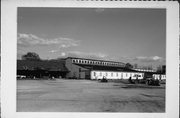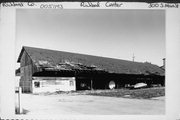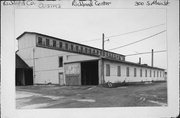| Additional Information: | Architectural Description:
Constructed as part of the Krouskop Lumber Yard established on the site in 1883, this wooden shed was built or was rebuilt and enlarged considerably between 1905 and 1912 (AB). Characterized by vertical wood siding, the building exhibits a shed roofed section with a drive through added in the early 20th century on the west side and a two-story monitor roofed section with a drive through on the east side. This lumber shed has continued to be used as a lumber shed up to the present time.
Architectural/Engineering Significance:
The Krouskop Lumber Shed is significant under Criterion C as a well-preserved example of an early lumber yard building. One of the few remaining examples of an early industrial building remaining in Richland Center, this lumber shed exhibits simple wood utilitarian character and a monitor roof that is typical of this lumber shed from this period. Other good examples of early extant industrial buildings in Richland Center are the remaining buildings in the proposed Krouskop Lumber Yard Historic District and the Pacific Coast Condensed Milk Plant at 920 Sextonville Road (20-17).
Historical Background:
The Krouskop Lumberyard Shed is a part of the Krouskop Lumberyard whose main mill was erected in 1883. Krouskop may have established the operation as early as 1878. However, hed did not acquire most of the land which the milling operation occupies until 1879-80. His mill eventually covered the area between the river to the west, Haseltine to the north, Main on the east extending to Central to include block 49, and Gage Street to the south (1). The 1883 mill structure burned in 1892, and Krouskop rebuilt and considerably expanded the brick mill by 1893 (2).
The yard reached full built capacity by 1911. In addition to the lumber sheds, major buildings at that date included other lumber sheds, the saw and planing mill, power house with a Worthington steam pump, kiln, grain warehouse, and livestock yards. The yard sat adjacent to the railroad, a facility indispensable to the transportation of its bulk products. Krouskop shipped many of his goods to Chicago for a broad distribution across the Midwest and Plains as well as engaging in local retail.
Krouskop wholesaled and retailed rough and finished lumber, sashes and doors, windows, oak flooring, moldings, siding, shingles, lathe, fencing, agricultural implements, and other building supplies. He also stored grain, feed, hay, coal, cement, and sand and kept livestock. Krouskop specifically advertised his wholesale business in 1909. He had maintained lumber warehouses occupying several blocks since the mid-1880's which suggests the extent of his business. Krouskop represents one of a limited number of commercial enterprises in Richland Center. After Krouskop's death in 1930, W.S. McCorkle and Carl Barnes gained his lumber operation (3).
Along with this lumber shed several others still line the west side of Main Street from Haseltine to Burton (RI20-27, 20-29, 20-31). Although this lumber shed appeared between 1905 and 1911, lumber sheds extended over blocks 50, 51, and 70 as early as 1883 (7).
Historical Significance:
The Krouskop Lumberyard Shed is viewed as an historically contributing component of the Krouskop Lumberyard Historic District. Like the other buildings, it acquires local historical significance under Criterion A in association with the Milling and Wood Products Topic of the Industry Theme and the Wholesale Topic of the Commerce Theme. As in Richland Center, the lumber industry became the leading industry in Wisconsin by the late nineteenth century. It thus gains local importance as a part of a common late nineteenth century phenomenon in Wisconsin. Its period of significance begins with the lumber shed's erection in 1905-1911 and ends with Krouskop's disassociation with the lumberyard through his death in 1930.
While the lumber milling industry developed early, markets did not rapidly expand until the 1870's when settlement of the prairies and the building of 2the railroad network began. Relying primarily on hardwoods, Richland Center's milling industry emerged with the processing of wood products in the late 1870's and 1880's. Lumber milling collapsed in most areas by the turn of the century. Richland Center's milling operation emerged during Wisconsin's years of peak production in the late 1880's and early 1890's (5). However, Richland Center's largest lumber mill and wood products manufacturer, the Krouskop Lumberyard, survived through not only milling but other areas of commerce and retail. It is the only surviving milling operation of the three which emerged in th elate nineteenth century along the Pine River. The other two include the N.L. James lumber mill and the Parfrey mills (6).
Thus, although with the exception of Krouskop's Lumberyard, much of the built environment no longer remains, the lumber industry contributed heavily to the economic development of Richland Center from the 1880's to the 1920's. It represents a common second phase in Wisconsin's industrial growth between the emphasis on flour milling and the dairy industry. Richland Center's development typifies the emergence of many southern Wisconsin communities located within the mixed forest belt (7). However, because the development of their lumber industry paled economically by comparison with those located in the pineries, the rise of this portion of the lumber industry is less well understood. The Krouskop lumber shed, one of the many which covered three blocks, contributes to the understanding of the local timber industry because it represents a portion of the development of the Krouskop Lumberyard. |
|---|
| Bibliographic References: | 1. Richland County Abstract Company, Indices to Land Records in the Richland County Courthouse (Richland Center: Richland County Abstract Company, n.d.); Democrat, April 9, 1930; Sanborn-Perris Map Company, Diagrammatic and Detailed City Maps Published for Use by Fire Insurance and Mortgage Companies (New York and Chicago: Sanborn-Perris Map Company, 1885-86); Ibid., 1892; Ibid., 1899; Ibid., 1905; Ibid., 1912; Ibid., 1927.
2. Democrat, May 3, 1937; Margaret Scott, Richland Center: A History (Richland Center: Richland County Publishers, 1972), p. 97.
3. Perl L. Lincoln, P.L. Lincoln Papers (Richland Center: Local History Room, Brewer Library, n.d. [Mss. uncatalogued]); Carl Burdock, The Chicken, the Egg, and the Omelet (Madison: Archives [Mss.], SHS, 1964); George Sinnett, Oral Interview (739 South Park, Richland Cneter, February 12, 1988); Local History Room, Brewer Library, Mss. 1645, 1073, 226); Sanborn-Perris Map Company, Ibid., 1885-86; Ibid., 1892; Ibid., 1899; Ibid., 1905; Ibid., 1912; Ibid., 1927; Scott, Ibid., pp. 158, 223; R.L. Polk & Co., Wisconsin Gazetteer and Business Directory (Chicago: R.L. Polk & Co., 1909), p. 1131.
4. Burdock, Ibid.,; Sanborn-Perris Map Company, Ibid., 1885-86; Ibid., 1892; Ibid., 1899; Ibid., 1905; Ibid., 1912; Ibid., 1927; Local History Room, Ibid., Mss. 1073.
5. Barbara Wyatt, Cultural Resource Management in Wisconsin (Madison: Historic Preservation Division, SHS, 1986), [Industry], II, 5-11, 14-15; Robert C. Nesbit, The History of Wisconsin: Urbanization and Industrialization. 1873-1893 (Madison: SHS, 1985), pp. 80, 310, 471; Scott, Ibid., 71.
6. Sanborn-Perris Map Company, Ibid., 1885-86; Ibid., 1892; Ibid., 1899, Ibid., 1905; Ibid., 1912; Ibid., 1927; Burdock, Ibid.
7. Burdock, Ibid.; Sinnett, Ibid.; Nesbit, Ibid., pp. 54-55, 82-83; Wyatt, Ibid., 5-8, 12-13; Richard Current, The History of Wisconsin: The Civil War Era, 1848-1873 (Madison: SHS, 1976), pp. 467-70.
A. Sanborn Insurance Map, City of Richland Center, (New York: Sanborn Map Co., 1886-1927).
B. Margaret Scott, Richland Center, Wisconsin, A History, (Richland Center: Richland County Publishing, 1972) pp. 71, 97. |
|---|



